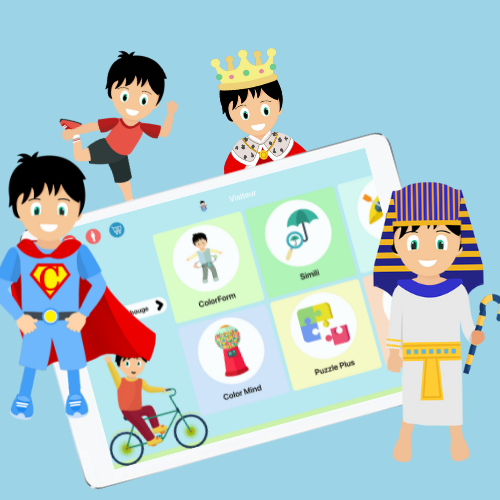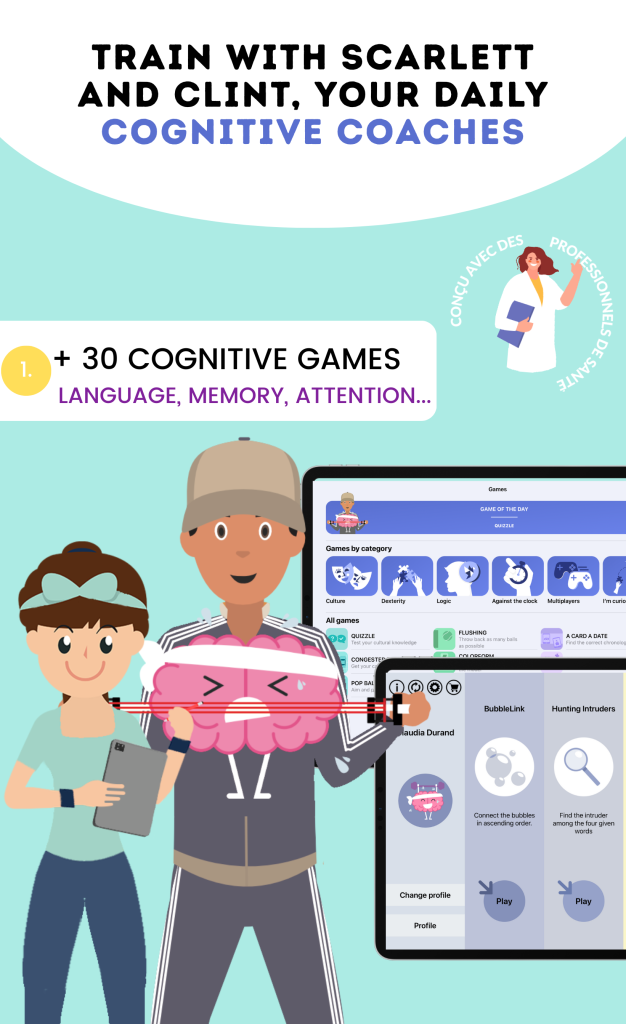When after-school homework looms on the horizon, the prospect can sometimes be a source of stress for both children and babysitters. However, transform these study moments into an educational and playful adventure with our collection of activity ideas. The goal is clear: to help children complete their homework while cultivating a fun and stimulating atmosphere. From online educational games to thrilling word hunts, and even movement-based math sessions, discover how to make after-school learning as enjoyable as it is instructive. These creative activities aim to awaken children’s curiosity and encourage their engagement in their homework in a way that brings smiles as well as thought. Get ready to transform homework routines into memorable educational adventures!
The Best Educational Activity Ideas
Online Educational Games
Integrate online educational games into the homework routine. Websites offer games that reinforce skills in math, reading, and science, making learning interactive and fun. You can also use the educational game program COCO THINKS and COCO MOVES, which will allow your children to work on their spelling, reading, math, history, and even English! Plus, every 15 minutes, a sports break will help them learn to detach from screens and avoid creating addictions. Rest assured!

Word Hunt
Transform vocabulary learning into a treasure hunt. Hide words around the house and encourage children to find them while associating them with definitions or using them in sentences.
Movement-Based Math
Use physical games to teach math concepts. Activities like jumping backward to add or hopscotch to practice multiplication tables make math more fun.
Two-Voice Stories
Read homework texts together in an interactive way. Each person takes a character, and together they read the text aloud, thus promoting comprehension and oral expression.

Multisensory Learning
Engage all senses during study time. Use tangible objects, bright colors, and encourage drawing or creating diagrams to help understand abstract concepts.
Quiz Competitions
Turn revisions into a quiz game. Ask questions related to the homework and reward correct answers with small prizes, thus creating a stimulating environment.
Creative Break
Incorporate creative breaks during homework. A short session of drawing, music, or dance can help relieve stress and stimulate creativity, thus promoting better learning.
Learning by Teaching
Encourage children to teach what they have learned. This reinforces their understanding of subjects while developing their communication skills.

Math Stories
Create stories that incorporate math problems. Children can solve the problems to advance in the story, thus making them more engaged in learning.
Here is a concrete example: The Lost Treasure Riddle
Imagine an exciting adventure in which your children are the heroes in search of a lost treasure. Each step of the journey presents math riddles to solve in order to advance in the story.
Scenario:
Our young adventurers, Emma and Lucas, discover an old treasure map in their grandmother’s attic. The map leads to a mysterious island where a legendary treasure is supposed to be hidden. However, to reach the treasure, they must overcome various math obstacles.
Riddle 1:
The children arrive at a river with three bridges. Each bridge has a guardian and a math riddle to solve. For example, the guardian of the first bridge asks the question: “If I have five apples and give two to each adventurer, how many do I have left?” The children must correctly solve the riddle to cross.
Riddle 2:
Once on the other side of the river, they discover a magical door with a numbered lock. The combination of the lock is based on math operations. For example, the instruction could be: “Multiply Emma’s age by Lucas’s age, then add the result to double the number of letters in the word ‘treasure’.” Only the correct answer will unlock the door.
Riddle 3:
Finally, the adventurers reach the place where the treasure is supposed to be buried. However, the treasure is surrounded by magical circles. The circles represent equations, and the children must solve each equation to unlock the treasure.
This engaging story combines adventure and math problem-solving, allowing children to learn while having fun. Each challenge they overcome brings them closer to the coveted treasure, while reinforcing their math skills in an interactive and memorable way.
Educational Role-Playing Games
Use role-playing games to explore academic concepts. For example, create an imaginary shop to teach money skills or act as historical figures to learn history.
Practical Tips for Supporting a Reluctant Child with Homework
Supporting a reluctant child with homework can be a challenge, but with a few tips, each study session can become a positive experience.
1. Create an Inviting Workspace
Set up a dedicated, well-lit, and comfortable workspace. Including colorful and inspiring supplies can help make the environment more welcoming.
2. Establish a Consistent Routine
Create a stable routine by setting regular times for homework. Predictability fosters concentration and acceptance of this study period.
3. Use Positive Rewards
Offer small rewards for each completed task. This can be as simple as extra playtime or praise to reinforce positive behavior.

Here are some examples of phrases you might use to set up positive rewards:
- Encourage Effort:
- “You really did well on your homework today, I am very proud of your efforts! As a reward, how about choosing the game we will play next?”
- Recognize Achievements:
- “Wow, you solved that complicated math problem! That’s impressive. As a reward, you can choose the dessert you want tonight.”
- Promote Collaboration:
- “I really appreciate how you helped your brother/sister with their homework. That’s a great attitude. As a reward, we can watch an episode of your favorite cartoon together.”
- Achieve Goals:
- “You finished all your homework ahead of schedule! As a reward, you can have extra time to play your favorite video game.”
- Value Creativity:
- “I love how you made this art assignment so colorful and creative. It’s really special. As a reward, how about choosing the movie we will watch tonight?”
- Encourage Responsibility:
- “You took the initiative to tidy up your study space after finishing your homework. That’s excellent behavior. As a reward, we can do an activity together that you enjoy.”
- Reinforce Perseverance:
- “Even though this problem was difficult, you didn’t get discouraged and kept trying. That’s exactly the attitude we’re looking for. As a reward, you can choose what we will have for dinner tonight.”
4. Explore Alternative Teaching Methods
Identify the child’s learning style. Some children prefer to learn visually, while others are more receptive to tactile or auditory approaches.
Tips for Choosing a Babysitter or Childcare Provider
Choosing the right babysitter or childcare provider is crucial for the safety, well-being, and happiness of your children. Here are some helpful tips to assist you in this important selection process.
Experience and References
Opt for a babysitter with proven experience in childcare. Ask for references from previous employers to get an idea of their reliability, competence, and professionalism.
First Aid Certifications and Training
Check if the babysitter has first aid certifications or training. These skills can be crucial in case of an emergency.
Compatibility with Children
Ensure that the babysitter has a personality compatible with your children’s. The ability to establish a positive connection contributes to creating a pleasant and safe environment.
Background Checks
Conduct background checks to ensure the integrity of the person. This may include criminal background checks and thorough interviews.

Questions to Ask in an Interview
During the interview, ask key questions to get to know the babysitter better:
- What is your experience in childcare and what age groups are you most comfortable with?
A question that helps assess the babysitter’s experience and ensure they are suitable for your children’s age. - How would you react in an emergency or critical situation?
This question evaluates the babysitter’s preparedness to handle difficult situations and their level of first aid competence. - What activities do you propose to entertain and educate children?
This question helps determine if the babysitter incorporates stimulating and educational activities into their childcare approach. - How do you handle conflicts between children?
An important question to assess the babysitter’s conflict resolution skills and their ability to maintain a peaceful environment.
By following these tips and asking relevant questions during the interview, you can choose a babysitter who meets your trust and competence criteria to ensure your children’s well-being.
Where to Find a Good Babysitter or Childcare Provider
Finding the ideal babysitter can sometimes be a challenge, but there are several resources where you can look:
1. Networks of Acquaintances
Ask for recommendations from your friends, neighbors, colleagues, or family members. Personal suggestions are often very reliable.
2. Local or Community Bulletin Boards
Check local bulletin boards, community announcements, or online groups where local babysitters might post their services.
3. Childcare Websites
Explore websites specialized in finding babysitters. Some sites provide detailed profiles, reviews, and information about certifications. We are pleased to introduce our partner Yoopies, a platform specializing in connecting families with qualified babysitters and childcare providers.
4. Support
The company Yoopies offers administrative and legal support. They have an automation system for declarations, payment for services, instant tax credit, and their goal is to reduce the mental load on households.

Strategies to Encourage Children’s Independence in Homework
Encouraging children to become independent in their homework is essential for their development. Here are some effective strategies:
- Set Clear Goals: Help children define specific goals for each homework session, such as finishing a chapter or solving a certain number of problems.
- Use a Calendar: Introduce a calendar or tracking board so they can visualize their progress and set deadlines.
- Encourage Decision-Making: Let them choose the order of their homework or the methods they want to use to complete it.
- Reinforce Confidence: Praise them for their efforts and achievements, even the small ones, to boost their self-confidence.
Group Activities to Make Homework More Fun
Group activities can transform the homework experience into a friendly moment. Here are some ideas:
- Study Workshops: Organize study sessions where several children gather to work together on their homework, promoting mutual help.
- Educational Board Games: Use board games that incorporate learning elements to make revisions more fun.
- Group Challenges: Set up challenges where children must solve problems together to win rewards.
- Creating Collaborative Projects: Encourage the creation of joint projects, such as a poster or presentation, that require everyone’s collaboration.
Integrating Technology into Learning
Technology can be valuable allies in learning. Here’s how to integrate it effectively:
- Educational Apps: Use apps that make learning interactive and engaging, such as quizzes or logic games.
- Online Platforms: Encourage the use of platforms that offer online courses or tutorials on specific subjects.
- Content Creation: Encourage children to create their own videos or presentations on topics they are studying to reinforce their understanding.
- Exchange Forums: Participate in online forums where children can ask questions and exchange ideas with their peers.
Encouraging Reading as a Learning Tool
Reading is a fundamental pillar of learning. Here are some ways to integrate it into homework routines:
- Choose Appropriate Books: Select books that match the child’s interests and reading level to stimulate their curiosity.
- Create a Reading Club: Form a reading club with friends to discuss the books read and share ideas.
- Relate Readings to Homework: Encourage children to make connections between what they read and their homework to enrich their understanding.
- Use Audiobooks: Integrate audiobooks to diversify reading experiences and help children develop their active listening skills.





